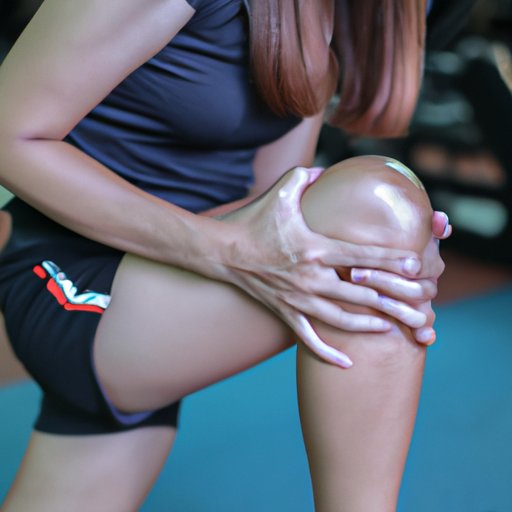Introduction
Knee pain is a common complaint that can be caused by a variety of medical conditions, including arthritis, tendonitis, bursitis, and injuries. Exercise can be an effective way to reduce knee pain and improve mobility. In this article, we will explore the types of exercise that are good for knee pain, their benefits, and how to incorporate them into your daily routine.

Specific Exercises to Help Reduce Knee Pain
When it comes to reducing knee pain, there are a variety of exercises that can be helpful. Here are some of the most effective ones:
Stretching
Stretching is one of the best ways to reduce knee pain. Stretching helps to increase flexibility in the muscles and ligaments that support the knee joint, which helps to reduce pain and improve range of motion. Some stretches that can be beneficial for knee pain include hamstring stretches, calf stretches, quadriceps stretches, and hip flexor stretches.
Physical Therapy
Physical therapy is another great option for those suffering from knee pain. A physical therapist can design an individualized program of exercises that target the specific muscles and ligaments that support the knee joint. Physical therapists can also provide guidance on proper form and technique to ensure that the exercises are done correctly.
Swimming
Swimming is a great low-impact exercise that can help to reduce knee pain. The buoyancy of the water takes pressure off of the joints, making it easier to move without causing further pain or damage. Additionally, swimming strengthens the muscles around the knee joint, which can help to improve stability and reduce pain.
Low-Impact Exercise
Low-impact exercises such as walking, biking, and using an elliptical machine are all excellent options for those with knee pain. These activities put less stress on the knees than running or jumping, while still providing a great workout. Many people find that adding low-impact exercises to their routine can help to reduce pain and improve mobility.

Strengthening Exercises to Relieve Knee Pain
Strengthening exercises are an important part of any knee pain management plan. Strengthening the muscles around the knee joint can help to improve stability and reduce pain. Here are some of the best strengthening exercises for knee pain:
Benefits of Strength Training
Strength training can help to reduce knee pain by strengthening the muscles and ligaments around the knee joint. Stronger muscles and ligaments can help to improve stability and reduce pain. Additionally, strength training can help to improve coordination and balance, which can also help to reduce pain.
Types of Exercises
There are a variety of exercises that can be used to strengthen the muscles and ligaments around the knee joint. Some of the most effective exercises for knee pain include leg lifts, calf raises, squats, and lunges. Additionally, using resistance bands or weights can help to increase the intensity of the exercises.
Yoga Poses for Knee Pain
Yoga is another great option for those suffering from knee pain. There are a variety of yoga poses that can help to reduce pain, improve flexibility, and strengthen the muscles and ligaments around the knee joint.
Benefits of Yoga
Yoga can help to reduce knee pain by improving flexibility, which can help to reduce stiffness and improve range of motion. Additionally, yoga can help to strengthen the muscles and ligaments around the knee joint, which can help to reduce pain and improve stability. Finally, yoga can help to reduce stress and tension, which can also help to reduce knee pain.
Different Poses
Some of the most beneficial yoga poses for knee pain include Virabhadrasana II (Warrior II Pose), Uttanasana (Standing Forward Bend Pose), Supta Padangusthasana (Reclining Big Toe Pose), and Baddha Konasana (Bound Angle Pose). When doing these poses, it’s important to listen to your body and not push yourself too hard.
Conclusion
Exercise is an effective way to reduce knee pain and improve mobility. There are a variety of exercises that can be beneficial, including stretching, physical therapy, swimming, low-impact exercise, and strength training. Additionally, yoga can be a great way to reduce pain, improve flexibility, and strengthen the muscles and ligaments around the knee joint. If you’re experiencing knee pain, it’s important to talk to your doctor before starting any new exercise routine.
Overall, exercise can be a great way to reduce knee pain and improve mobility. By incorporating stretching, physical therapy, swimming, low-impact exercise, strength training, and yoga into your routine, you can help to reduce pain and improve your quality of life.
Summary of Article
This article explored the types of exercise that can help reduce knee pain, their benefits, and how to incorporate them into your daily routine. We discussed stretching, physical therapy, swimming, low-impact exercise, strength training, and yoga poses, and their respective benefits. We also highlighted the importance of talking to your doctor before beginning any new exercise routine.
Recommendations
If you are suffering from knee pain, exercise can be an effective way to reduce pain and improve mobility. It is important to talk to your doctor before starting any new exercise routine, and to start slowly and build up gradually. Incorporating stretching, physical therapy, swimming, low-impact exercise, strength training, and yoga into your routine can help to reduce pain and improve your quality of life.
(Note: Is this article not meeting your expectations? Do you have knowledge or insights to share? Unlock new opportunities and expand your reach by joining our authors team. Click Registration to join us and share your expertise with our readers.)
